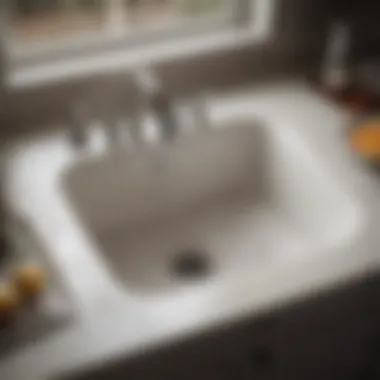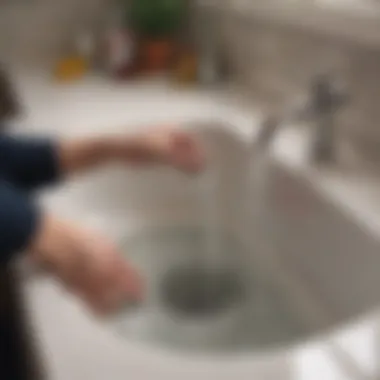Effective Methods to Fix a Clogged Sink Drain


Intro
Clogged sink drains present a common issue for households. Understanding the nature of the problem and finding effective solutions is essential. Blockages can stem from various sources, including buildup from food particles, grease, or foreign objects. This article will guide you through the process of diagnosing and fixing a clogged sink drain using practical methods and tools.
Ensuring efficient drainage is not just a matter of convenience; it also impacts the overall hygiene of your home. A blocked sink can lead to unpleasant odors, overflow, and even water damage if not addressed promptly. This article will cover several strategies ranging from simple DIY fixes to advanced plumbing techniques. Readers will learn to identify the root cause of blockages and make informed decisions about tackling them.
Key Topics
- Identifying types of clogs
- DIY methods for unclogging
- Advanced plumbing solutions
- Tools and materials required
- Safety precautions
- Maintenance tips to prevent future issues
By the end of this article, you will have the knowledge needed to resolve common drain issues efficiently, safeguarding your home's integrity.
Understanding Clogged Sink Drains
Understanding clogged sink drains is crucial in maintaining a healthy plumbing system in any home. Clogs can lead to various issues, including unpleasant odors, water damage, and costly repairs. Addressing these problems promptly can ensure that the household remains comfortable and operational. It promotes a more efficient drainage system, preventing the accumulation of waste and debris.
Common Causes of Clog in Sink Drains
A range of factors can contribute to sink drain clogs. Some of the most common include:
- Food Particles: Small bits of food can build up over time, especially if they are not disposed of properly.
- Grease: When cooking grease is washed down the sink, it can solidify and adhere to the pipes, creating a blockage.
- Hair: This is especially notable in bathroom sinks, where long strands can accumulate and trap other debris.
- Soap Scum: Bar soap and body washes can leave residues that congeal and restrict water flow.
- Foreign Objects: Items such as toys, utensils, or similar objects can accidentally fall into the sink, causing an unexpected blockage.
Understanding these common causes can help in both prevention and in identifying what may have led to the clog when it occurs.
The Impact of a Clogged Drain
The effects of a clogged drain extend beyond just inconvenience. Some significant impacts include:
- Water Backup: Water may begin to pool in the sink or even overflow, leading to potential water damage.
- Unpleasant Odors: Standing water and decomposing food particles can produce foul smells that permeate the home.
- Mold Growth: Persistent water can lead to mold development, causing health risks and requiring professional remediation.
- Costly Repairs: If the clog leads to significant damage, it may result in expensive plumbing work or even require replacing fixtures.
A clogged sink is not just a minor annoyance; it can escalate into serious issues that affect both your home environment and your finances.
A proactive approach, including regular assessment and maintenance, can mitigate these impacts. The knowledge of common causes and consequences helps homeowners better navigate potential issues before they escalate.
Initial Assessment and Diagnosis
The initial assessment and diagnosis phase plays a critical role in addressing clogged sink drains effectively. Understanding the problem fully before attempting to resolve it can save time and prevent damage to plumbing systems. This section highlights key elements that contribute to successful clog resolution.
By observing the symptoms and gathering necessary tools, one can pinpoint the cause of the blockage. This approach also helps one avoid ineffective methods that could complicate matters further. Evaluating the severity of the clog helps decide whether a DIY solution is sufficient or if a professional is required.
Overall, this diagnostic phase sets the groundwork for efficient and effective solutions, making it an indispensable step in the journey toward a functional sink again.
Identifying Symptoms of a Clog
Recognizing the symptoms of a clogged sink drain is vital. Common indicators include slow drainage, unpleasant odors, and, in some cases, gurgling sounds. Each symptom provides clues about the nature of the blockage. Slow drainage often suggests buildup caused by food particles, grease, or soap scum. Odors frequently indicate decomposing materials in the plumbing. Gurgling may signal trapped air due to a significant obstruction.
By noting these symptoms, one can assess the situation better and determine the necessary steps to take. Early identification can prevent more severe issues, such as pipe bursts, that might stem from prolonged clogs.
Gathering Necessary Tools
When facing a clogged sink, having the right tools is essential for an effective resolution. The following tools are commonly employed:


Plunger
The plunger is a fundamental plumbing tool known for its simplicity and effectiveness. Among its key characteristics is its design, which creates suction to dislodge clogs. This makes it a popular choice for initial attempts at clearing simple blockages.
The unique feature of the plunger is its ability to exert pressure quickly, breaking up minor clogs without the need for chemicals. However, it may not be suitable for more severe or deeper clogs, where additional methods may be necessary.
Drain snake
A drain snake is an essential tool when the clog is deeper in the plumbing system. This flexible device can reach difficult spots that a plunger cannot. Its key characteristic is its ability to navigate bends in pipes while grabbing or breaking apart the obstruction.
Using a drain snake can be particularly beneficial for hair or solid material blockages. However, care must be taken, as improper use can cause damage to pipes. It is essential to follow guidelines for effective performance.
Bucket
A bucket serves a vital practical purpose during the unclogging process. Its primary role is to catch water and debris that may escape during repairs, minimizing mess and damage to the area. A bucket is often a starting point when dealing with clogs, providing a place to collect overflow or waste.
The unique feature of a bucket is its versatility. It can also be used to mix cleaning solutions or hold tools as needed. However, it does not directly assist in removing the clog itself, meaning it is used in conjunction with other tools for the best results.
Assembling these tools creates a solid foundation for tackling clogged drain issues effectively. By understanding their roles, one can approach the situation with confidence and a structured plan.
Basic Methods to Clear Clogs
In addressing a clogged sink drain, employing effective methods to clear clogs is essential. These methods are often the first line of defense before considering more invasive solutions. Understanding basic techniques not only helps in resolving the issue but also empowers individuals by instilling confidence in handling common plumbing problems.
Familiarity with these methods allows for a quicker diagnosis of the situation and helps avoid unnecessary expenses. It is also advantageous to learn about the limitations of each approach—some are better suited for minor clogs, while others can tackle more stubborn blockages. Furthermore, the successful application of these techniques can lead to improved maintenance practices that prevent future occurrences.
Using a Plunger
A plunger is an invaluable tool when dealing with sink clogs. It works by creating pressure that can dislodge blockages.
Steps to Use a Plunger:
- Choose the Right Plunger: Make sure to use a cup plunger for sink drains. The flat bottom creates a better seal.
- Remove any Standing Water: If there is a significant amount of water in the sink, try to remove some. This helps the plunger work more effectively.
- Position the Plunger: Place the cup over the drain hole and ensure that it covers the entire opening.
- Create a Seal: Press down gently first, then forcefully pump up and down. The key is to maintain the seal to create pressure when plunging.
- Check the Results: After several thrusts, pull the plunger away and observe if the water drains. Repeat as necessary until the blockage clears.
Using a plunger is a straightforward method; however, it requires proper technique and may not always work for tougher clogs.
Employing a Drain Snake
If plunging fails, a drain snake is a more aggressive approach to clearing stubborn blockages. A drain snake, or auger, can reach deeper into pipes, breaking up clogs that are not reachable by other methods.
Steps to Use a Drain Snake:
- Insert the Snake: Push the snake into the drain until you feel resistance. This indicates a clog.
- Rotate the Handle: Turn the handle clockwise. This action allows the snake to break through clogs, whether they are caused by hair, grease, or foreign objects.
- Withdraw the Snake: Slowly pull the snake out, and be prepared for debris to come up with it.
- Run Water: After removing the clogged material, run water down the drain to ensure everything is flowing correctly.
Investing in a drain snake is worthwhile for those who often encounter clogs. Unlike plungers, drain snakes can provide solutions for complex blockages that require more persistence.
"Combining these methods effectively can save time and effort, enhancing your ability to address stubborn clogs at home."
Understanding how to use each of these tools effectively will enhance the reader's ability to manage their plumbing needs proactively.
Chemical Solutions for Stubborn Clogs
In the realm of plumbing, some sink clogs present a more formidable challenge than others. Chemical solutions have emerged as an effective means of addressing such stubborn blockages. Understanding their application is vital for homeowners looking for efficient ways to restore proper drainage in their sinks.


Understanding Chemical Drain Cleaners
Chemical drain cleaners are formulated to dissolve the materials causing the blockage in your sink. These products come in various forms, including liquid, gel, and powder, and can contain powerful ingredients like sodium hydroxide, sulfuric acid, or hydrogen peroxide. Each type works differently and is suitable for specific clogs.
When considering chemical cleaners, it is important to recognize their effectiveness alongside their limitations:
- Speed: These cleaners typically work quickly, often providing results in a matter of minutes.
- Strength: They can penetrate blockages that mechanical methods may fail to dislodge.
- Convenience: They require minimal effort, making them appealing for those who prefer not dealing with mechanical tools.
However, chemical solutions also come with significant risks. They can be harsh on plumbing and may cause damage if used improperly or too frequently. Always read labels and instructions carefully before utilizing these products.
Safety Precautions with Chemical Cleaners
Using chemical drain cleaners necessitates a clear understanding of safety practices to hinder potential hazards. Improper use can lead to harmful situations, both for you and your plumbing system. Here are updated safety precautions one should follow:
- Protective Gear: Always wear gloves and goggles when handling these chemicals. This protective gear shields you from splashes and skin contact.
- Ventilation: Ensure the area is well-ventilated. Fumes can be harmful, and adequate airflow will reduce inhalation risks.
- Follow Instructions: Every product comes with specific usage guidelines. It is crucial to adhere strictly to these instructions. Incorrect amounts or combinations can lead to dangerous chemical reactions.
- Avoid Mixing: Never mix drain cleaners with other household substances. Such combinations can produce toxic gases or exacerbate plumbing issues.
"Safety first should be our motto when tackling clogged drains with chemical solutions."
In summary, while chemical solutions can effectively address stubborn clogs, understanding their use, risks, and necessary precautions is essential. This ensures both safe handling and successful results.
Natural Remedies for Clog Removal
Natural remedies for unclogging sink drains are important alternatives to more chemical-intensive solutions. They often utilize common household items, making them both accessible and cost-effective. When we consider the environmental impact and the potential health risks of harsh chemicals, exploring natural options becomes relevant. These methods can effectively address minor blockages while promoting sustainable practices. Additionally, they often come with fewer safety hazards, allowing for more peace of mind during the unclogging process.
Baking Soda and Vinegar Method
The baking soda and vinegar method is a popular natural remedy for sink clogs. This approach is based on a simple chemical reaction that occurs when these two substances interact. Baking soda is alkaline, while vinegar is acidic. When combined, they create carbon dioxide gas, which can help dislodge stubborn debris inside the drain.
To use this method:
- Start by clearing the sink of any standing water if possible. This allows the solution to flow down the drain more effectively.
- Pour 1/2 cup of baking soda directly into the drain. Let it sit for a few minutes.
- Follow it with 1/2 cup of vinegar. You may notice fizzing and bubbling sounds as the reaction occurs. This is a good sign.
- Cover the drain with a cloth or stopper to keep the reaction contained.
- Wait for about 30 minutes before flushing the drain with hot water. This should clear away some of the buildup.
This technique not only addresses clogs but can also help maintain a fresh-smelling drain. Regular usage can prevent future obstructions.
Using Hot Water
Using hot water is another effective, straightforward remedy for clogged sinks. This method works well on greasy or oily blockages. The heat from the water can help dissolve any accumulated fats and oils, enabling them to flow freely down the drain.
To effectively implement this method:
- Boil water in a kettle or pot. Ensure you have enough to pour down the drain.
- Carefully pour the hot water down the drain in stages. Allow it to sit for a few moments between pours. This will increase the chances of breaking up any clogs.
- Repeat if necessary, especially if the sink is still slow to drain after the first attempt. Sometimes, persistent clogs require more than one application of hot water.
It is crucial to remember that while these natural remedies can be effective, they may not resolve all issues. More serious clogs may still warrant professional attention. However, employing these methods regularly can help maintain a clear and efficient drain.
When to Call a Professional
Understanding when to call a plumbing professional is essential in the conversation about clogged sink drains. While many issues can be resolved through DIY methods, certain situations require the expertise of a trained technician. Recognizing these moments can save time, money, and potentially further damage to your plumbing system.
When facing a recurring clog, it is critical to assess the situation. If you find that your sink continues to clog after multiple attempts to clear it, the problem may lie deeper within your plumbing. It could indicate a larger issue, such as a blockage in the main sewer line, which could require specialized equipment to diagnose and resolve. Other indicators that it might be time to seek professional help include:
- Unusual Sounds: Gurgling noises emanating from the sink or plumbing could suggest air trapped in the system due to a blockage.
- Multiple Drains Affected: If other drains in your home are also slow or completely clogged, this could signal a more systemic problem rather than an isolated issue.
- Visible Signs: Water backing up in spaces where it's not supposed to occur, such as under sinks or in bathtubs, is a clear sign of a more serious plumbing issue.


Seeking assistance early can prevent more severe damage and help maintain the integrity of your home fixtures.
Recognizing Complex Issues
Complex plumbing issues often present symptoms that can be easily mistaken for simpler problems. Being able to recognize these complexities can significantly influence your decision to call a professional. Some additional signs include:
- Foul Odors: Persistent, unpleasant smells could indicate stagnant water or decomposing material trapped within pipes.
- Inconsistent Water Flow: If the water pressure changes unexpectedly, it might suggest issues upstream or within your plumbing.
- Corrosion or Dampness: Signs of corrosion on pipes or wet spots around plumbing fixtures might indicate leaks or impending failures.
It is crucial to not ignore these red flags. Attempting to fix deeply-ingrained issues without professional help can lead to costly repairs.
Choosing the Right Plumber
Not all plumbers offer the same level of expertise. Choosing the right professional can make a significant difference in resolving your plumbing woes effectively. Here are a few considerations to keep in mind:
- Reputation: Look for reviews and testimonials of local plumbers. A professional with positive feedback is more likely to deliver satisfactory results.
- Licensing and Insurance: Ensure that the plumber holds a valid license and insurance. This protects you in case of damages or other issues that may arise during the repair process.
- Experience with Similar Issues: It can be beneficial to hire a plumber who has specific experience with sink clogs, especially if you suspect a complex issue is at hand.
By taking the time to find the right professional, you can ensure that your clogged sink drain is addressed efficiently, minimizing future problems.
Remember, it is better to call for help early than to wait for the problem to escalate.
Preventative Measures to Avoid Future Clogs
Preventing clogged sink drains is often more effective than dealing with the aftermath of the blockage. Understanding the factors that lead to clogs significantly minimizes maintenance efforts and potential damage to plumbing systems. These preventative measures not only enhance the overall flow of water but also extend the lifespan of sink fixtures and plumbing components.
Regular Maintenance Strategies
Implementing a routine maintenance schedule can drastically reduce the chances of sinks clogging.
- Periodic Cleaning: Regularly clean your sink drains by flushing them with hot water. This simple act helps dissolve any grease or soap residue that may accumulate over time.
- Strainer Installation: Placing strainers in the drain openings is a straightforward yet impactful strategy. Strainers catch food particles, hair, and debris, preventing them from entering the drain and causing obstructions.
- Bi-Annual Deep Cleaning: A thorough cleaning using natural or chemical drain cleaners every six months can support proper drainage. However, remember to follow safety precautions while using chemical cleaners.
Integrating these strategies consistently can help homeowners maintain clear and functional sink drains, making day-to-day use of the kitchen and bathroom trouble-free.
Proper Disposal Guidelines
Proper disposal of items is crucial in preventing sink clogs. Many people may not realize that improper discards can lead directly to drainage issues.
- Avoid Pouring Oil or Grease: Residues from cooking oils and fats solidify and cling to pipes, causing severe blockages. Instead, dispose of them in a composting bin or designated container.
- Dispose of Food Waste Carefully: Food particles can accumulate in the drain. Use a compost bin for vegetable scraps and trash for any solid food waste.
- Educate Family Members: Ensure everyone in the household is aware of what should and shouldn’t go down the sink, helping to avoid accidents.
By cultivating responsible disposal habits and routine practices, individuals can significantly lower the risk of experiencing clogged sinks, promoting their long-term functionality and efficiency.
"An ounce of prevention is worth a pound of cure."
- Benjamin Franklin
Taking the time to implement preventative measures will pay off in the long run, both in convenience and cost-saving.
Epilogue
The conclusion serves as a pivotal element in comprehending the intricacies of tackling a clogged sink drain. It synthesizes the key takeaways, emphasizing not just the methods discussed but also the underlying principles necessary for effective maintenance. A well-functioning sink is integral to home hygiene and efficiency, illustrating why addressing clogs promptly prevents escalation and prolonged inconveniences.
Recap of Solutions and Care Tips
To sum up the strategies outlined throughout the article, consider the following points:
- Initial Diagnosis: Always begin by identifying the symptoms of a clog, ensuring proper assessment before attempting fixes.
- Tools You Need: Ensure the availability of basic tools such as a plunger, drain snake, and a bucket. These will address most clogs effectively.
- Chemical and Natural Remedies: While chemical solutions are available, exploring natural options like baking soda and vinegar can be both eco-friendly and effective.
- Calling Professionals: Recognize when to involve a plumbing professional, particularly for complex or recurring issues. This may save further damage and costs in long run.
- Preventative Practices: Implement regular maintenance, such as cleaning out the drain and avoiding disposal of non-biodegradable items.
These care tips not only enhance your immediate situation but also reinforce long-term practices that safeguard your plumbing. Regular attention to these matters fosters a smoother domestic experience, proving that thorough understanding and proactive measures can drastically reduce the likelihood of future clogs.
Ultimately, this holistic consideration not only equips readers with practical know-how but also encourages a mindful approach to home care.















